Immigrants from Africa vs Assyrian/Chaldean/Syriac Community Comparison
COMPARE
Immigrants from Africa
Assyrian/Chaldean/Syriac
Social Comparison
Social Comparison
Immigrants from Africa
Assyrians/Chaldeans/Syriacs
3,479
SOCIAL INDEX
32.3/ 100
SOCIAL RATING
219th/ 347
SOCIAL RANK
7,301
SOCIAL INDEX
70.5/ 100
SOCIAL RATING
124th/ 347
SOCIAL RANK
Assyrian/Chaldean/Syriac Integration in Immigrants from Africa Communities
The statistical analysis conducted on geographies consisting of 107,315,136 people shows no correlation between the proportion of Assyrians/Chaldeans/Syriacs within Immigrant from Africa communities in the United States with a correlation coefficient (R) of -0.025. On average, for every 1% (one percent) increase in Immigrants from Africa within a typical geography, there is a decrease of 0.000% in Assyrians/Chaldeans/Syriacs. To illustrate, in a geography comprising of 100,000 individuals, a rise of 1,000 Immigrants from Africa corresponds to a decrease of 0.5 Assyrians/Chaldeans/Syriacs.
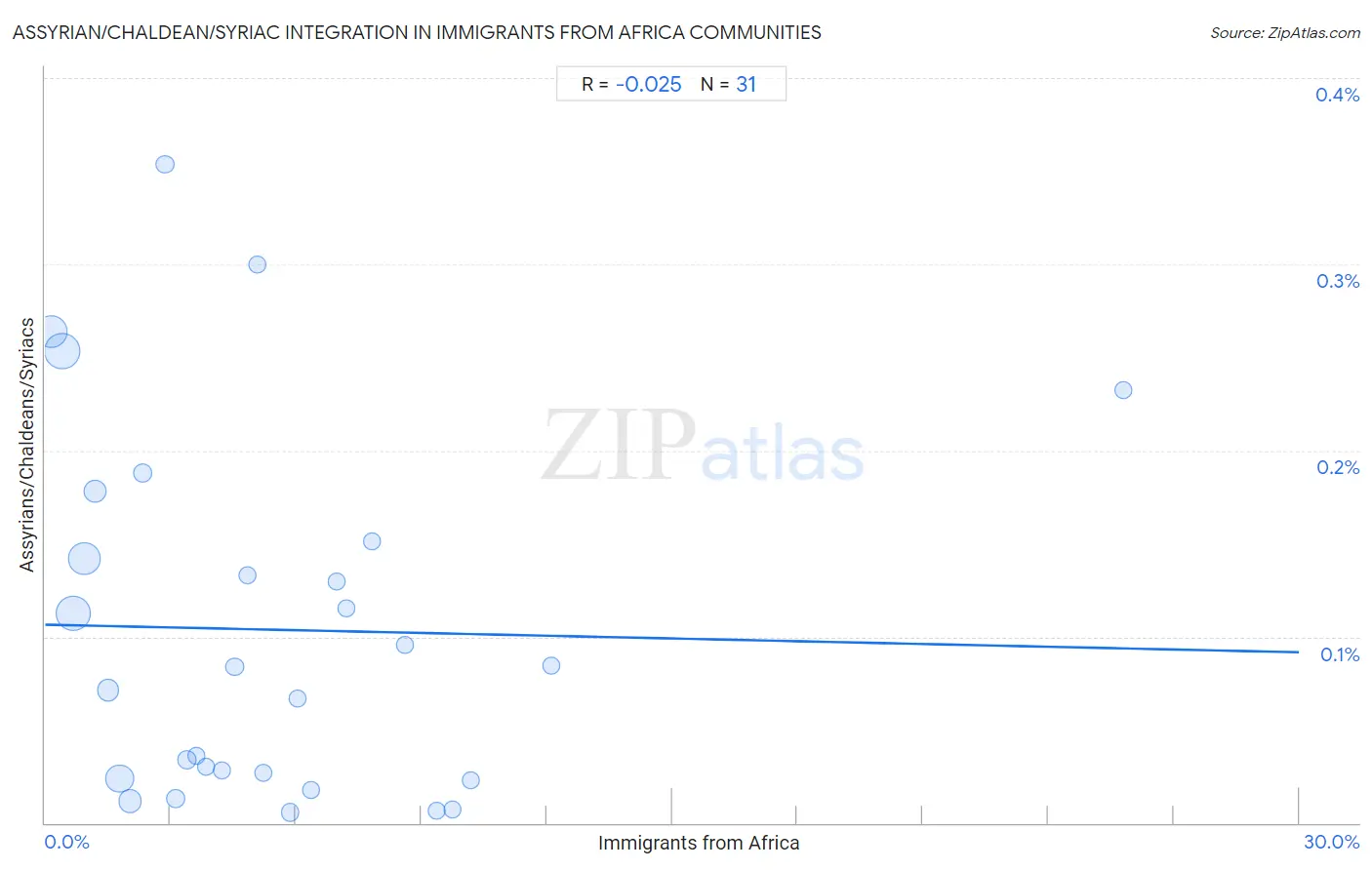
Immigrants from Africa vs Assyrian/Chaldean/Syriac Income
When considering income, the most significant differences between Immigrants from Africa and Assyrian/Chaldean/Syriac communities in the United States are seen in wage/income gap (23.2% compared to 31.0%, a difference of 33.7%), householder income under 25 years ($50,609 compared to $65,329, a difference of 29.1%), and householder income ages 45 - 64 years ($97,284 compared to $110,201, a difference of 13.3%). Conversely, both communities are more comparable in terms of median female earnings ($40,257 compared to $39,159, a difference of 2.8%), median earnings ($46,564 compared to $48,304, a difference of 3.7%), and per capita income ($42,950 compared to $45,195, a difference of 5.2%).

| Income Metric | Immigrants from Africa | Assyrian/Chaldean/Syriac |
| Per Capita Income | Fair $42,950 | Excellent $45,195 |
| Median Family Income | Fair $100,256 | Exceptional $109,622 |
| Median Household Income | Fair $83,289 | Exceptional $91,991 |
| Median Earnings | Average $46,564 | Exceptional $48,304 |
| Median Male Earnings | Fair $53,457 | Exceptional $58,437 |
| Median Female Earnings | Good $40,257 | Fair $39,159 |
| Householder Age | Under 25 years | Tragic $50,609 | Exceptional $65,329 |
| Householder Age | 25 - 44 years | Tragic $90,372 | Exceptional $101,936 |
| Householder Age | 45 - 64 years | Poor $97,284 | Exceptional $110,201 |
| Householder Age | Over 65 years | Fair $59,837 | Exceptional $64,108 |
| Wage/Income Gap | Exceptional 23.2% | Tragic 31.0% |
Immigrants from Africa vs Assyrian/Chaldean/Syriac Poverty
When considering poverty, the most significant differences between Immigrants from Africa and Assyrian/Chaldean/Syriac communities in the United States are seen in female poverty among 18-24 year olds (21.0% compared to 13.7%, a difference of 52.9%), child poverty under the age of 5 (18.6% compared to 13.6%, a difference of 37.0%), and child poverty among girls under 16 (18.2% compared to 13.3%, a difference of 36.5%). Conversely, both communities are more comparable in terms of married-couple family poverty (5.5% compared to 4.9%, a difference of 11.4%), seniors poverty over the age of 75 (12.9% compared to 10.7%, a difference of 20.3%), and receiving food stamps (12.8% compared to 10.6%, a difference of 20.5%).
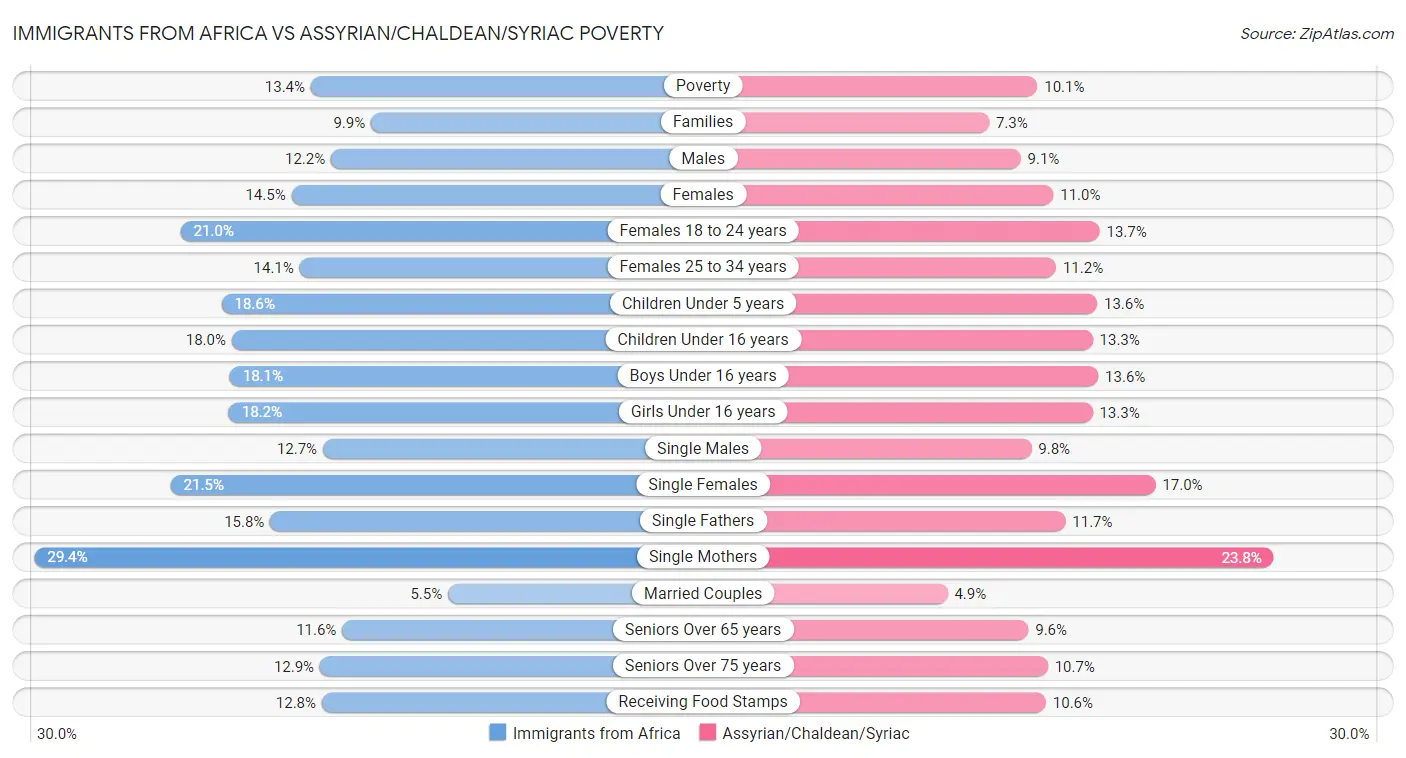
| Poverty Metric | Immigrants from Africa | Assyrian/Chaldean/Syriac |
| Poverty | Tragic 13.4% | Exceptional 10.1% |
| Families | Tragic 9.9% | Exceptional 7.3% |
| Males | Tragic 12.2% | Exceptional 9.1% |
| Females | Tragic 14.5% | Exceptional 11.0% |
| Females 18 to 24 years | Tragic 21.0% | Exceptional 13.7% |
| Females 25 to 34 years | Poor 14.1% | Exceptional 11.2% |
| Children Under 5 years | Tragic 18.6% | Exceptional 13.6% |
| Children Under 16 years | Tragic 18.0% | Exceptional 13.3% |
| Boys Under 16 years | Tragic 18.1% | Exceptional 13.6% |
| Girls Under 16 years | Tragic 18.2% | Exceptional 13.3% |
| Single Males | Good 12.7% | Exceptional 9.8% |
| Single Females | Poor 21.5% | Exceptional 17.0% |
| Single Fathers | Exceptional 15.8% | Exceptional 11.7% |
| Single Mothers | Fair 29.4% | Exceptional 23.8% |
| Married Couples | Poor 5.5% | Excellent 4.9% |
| Seniors Over 65 years | Tragic 11.6% | Exceptional 9.6% |
| Seniors Over 75 years | Tragic 12.9% | Exceptional 10.7% |
| Receiving Food Stamps | Tragic 12.8% | Exceptional 10.6% |
Immigrants from Africa vs Assyrian/Chaldean/Syriac Unemployment
When considering unemployment, the most significant differences between Immigrants from Africa and Assyrian/Chaldean/Syriac communities in the United States are seen in unemployment among women with children ages 6 to 17 years (9.4% compared to 7.2%, a difference of 30.1%), unemployment among seniors over 75 years (9.0% compared to 11.1%, a difference of 22.7%), and unemployment among women with children under 6 years (7.7% compared to 6.5%, a difference of 19.9%). Conversely, both communities are more comparable in terms of unemployment among ages 16 to 19 years (18.0% compared to 17.9%, a difference of 0.76%), unemployment among ages 45 to 54 years (4.6% compared to 4.7%, a difference of 1.7%), and unemployment among youth under 25 years (12.1% compared to 11.9%, a difference of 2.2%).
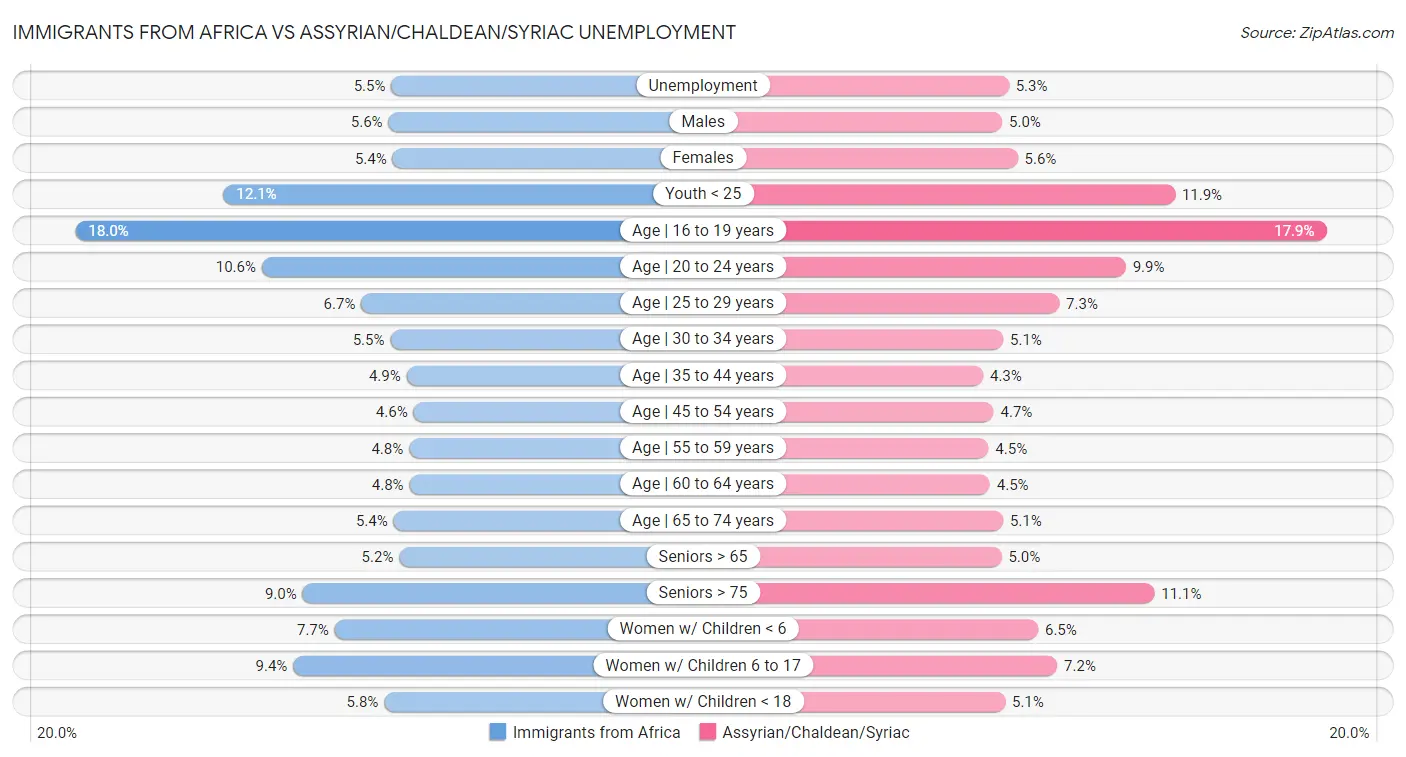
| Unemployment Metric | Immigrants from Africa | Assyrian/Chaldean/Syriac |
| Unemployment | Tragic 5.5% | Fair 5.3% |
| Males | Tragic 5.6% | Exceptional 5.0% |
| Females | Tragic 5.4% | Tragic 5.6% |
| Youth < 25 | Tragic 12.1% | Tragic 11.9% |
| Age | 16 to 19 years | Poor 18.0% | Fair 17.9% |
| Age | 20 to 24 years | Tragic 10.6% | Exceptional 9.9% |
| Age | 25 to 29 years | Average 6.7% | Tragic 7.3% |
| Age | 30 to 34 years | Fair 5.5% | Exceptional 5.1% |
| Age | 35 to 44 years | Tragic 4.9% | Exceptional 4.3% |
| Age | 45 to 54 years | Poor 4.6% | Tragic 4.7% |
| Age | 55 to 59 years | Good 4.8% | Exceptional 4.5% |
| Age | 60 to 64 years | Excellent 4.8% | Exceptional 4.5% |
| Age | 65 to 74 years | Fair 5.4% | Exceptional 5.1% |
| Seniors > 65 | Fair 5.2% | Exceptional 5.0% |
| Seniors > 75 | Tragic 9.0% | Tragic 11.1% |
| Women w/ Children < 6 | Fair 7.7% | Exceptional 6.5% |
| Women w/ Children 6 to 17 | Tragic 9.4% | Exceptional 7.2% |
| Women w/ Children < 18 | Tragic 5.8% | Exceptional 5.1% |
Immigrants from Africa vs Assyrian/Chaldean/Syriac Labor Participation
When considering labor participation, the most significant differences between Immigrants from Africa and Assyrian/Chaldean/Syriac communities in the United States are seen in in labor force | age > 16 (67.4% compared to 64.0%, a difference of 5.2%), in labor force | age 30-34 (85.3% compared to 83.2%, a difference of 2.5%), and in labor force | age 20-64 (80.4% compared to 79.4%, a difference of 1.2%). Conversely, both communities are more comparable in terms of in labor force | age 20-24 (75.8% compared to 75.9%, a difference of 0.020%), in labor force | age 45-54 (83.2% compared to 83.2%, a difference of 0.030%), and in labor force | age 25-29 (85.2% compared to 84.7%, a difference of 0.62%).

| Labor Participation Metric | Immigrants from Africa | Assyrian/Chaldean/Syriac |
| In Labor Force | Age > 16 | Exceptional 67.4% | Tragic 64.0% |
| In Labor Force | Age 20-64 | Exceptional 80.4% | Fair 79.4% |
| In Labor Force | Age 16-19 | Exceptional 38.0% | Exceptional 38.3% |
| In Labor Force | Age 20-24 | Exceptional 75.8% | Exceptional 75.9% |
| In Labor Force | Age 25-29 | Exceptional 85.2% | Average 84.7% |
| In Labor Force | Age 30-34 | Exceptional 85.3% | Tragic 83.2% |
| In Labor Force | Age 35-44 | Exceptional 84.9% | Tragic 84.0% |
| In Labor Force | Age 45-54 | Exceptional 83.2% | Exceptional 83.2% |
Immigrants from Africa vs Assyrian/Chaldean/Syriac Family Structure
When considering family structure, the most significant differences between Immigrants from Africa and Assyrian/Chaldean/Syriac communities in the United States are seen in single mother households (7.3% compared to 4.8%, a difference of 51.4%), births to unmarried women (33.0% compared to 22.0%, a difference of 50.2%), and single father households (2.4% compared to 2.0%, a difference of 21.2%). Conversely, both communities are more comparable in terms of average family size (3.25 compared to 3.24, a difference of 0.10%), family households with children (28.0% compared to 28.1%, a difference of 0.51%), and family households (62.4% compared to 68.2%, a difference of 9.3%).

| Family Structure Metric | Immigrants from Africa | Assyrian/Chaldean/Syriac |
| Family Households | Tragic 62.4% | Exceptional 68.2% |
| Family Households with Children | Exceptional 28.0% | Exceptional 28.1% |
| Married-couple Households | Tragic 42.9% | Exceptional 51.8% |
| Average Family Size | Good 3.25 | Good 3.24 |
| Single Father Households | Fair 2.4% | Exceptional 2.0% |
| Single Mother Households | Tragic 7.3% | Exceptional 4.8% |
| Currently Married | Tragic 43.9% | Exceptional 50.8% |
| Divorced or Separated | Fair 12.1% | Exceptional 10.6% |
| Births to Unmarried Women | Poor 33.0% | Exceptional 22.0% |
Immigrants from Africa vs Assyrian/Chaldean/Syriac Vehicle Availability
When considering vehicle availability, the most significant differences between Immigrants from Africa and Assyrian/Chaldean/Syriac communities in the United States are seen in no vehicles in household (12.5% compared to 7.0%, a difference of 79.4%), 4 or more vehicles in household (5.6% compared to 7.2%, a difference of 28.1%), and 3 or more vehicles in household (17.6% compared to 21.7%, a difference of 23.7%). Conversely, both communities are more comparable in terms of 1 or more vehicles in household (87.6% compared to 93.0%, a difference of 6.3%), 2 or more vehicles in household (51.8% compared to 60.5%, a difference of 16.9%), and 3 or more vehicles in household (17.6% compared to 21.7%, a difference of 23.7%).

| Vehicle Availability Metric | Immigrants from Africa | Assyrian/Chaldean/Syriac |
| No Vehicles Available | Tragic 12.5% | Exceptional 7.0% |
| 1+ Vehicles Available | Tragic 87.6% | Exceptional 93.0% |
| 2+ Vehicles Available | Tragic 51.8% | Exceptional 60.5% |
| 3+ Vehicles Available | Tragic 17.6% | Exceptional 21.7% |
| 4+ Vehicles Available | Tragic 5.6% | Exceptional 7.2% |
Immigrants from Africa vs Assyrian/Chaldean/Syriac Education Level
When considering education level, the most significant differences between Immigrants from Africa and Assyrian/Chaldean/Syriac communities in the United States are seen in doctorate degree (2.0% compared to 1.7%, a difference of 19.0%), college, under 1 year (65.3% compared to 67.7%, a difference of 3.7%), and college, 1 year or more (59.6% compared to 61.5%, a difference of 3.2%). Conversely, both communities are more comparable in terms of 3rd grade (97.4% compared to 97.4%, a difference of 0.020%), 2nd grade (97.5% compared to 97.5%, a difference of 0.040%), and nursery school (97.6% compared to 97.6%, a difference of 0.060%).
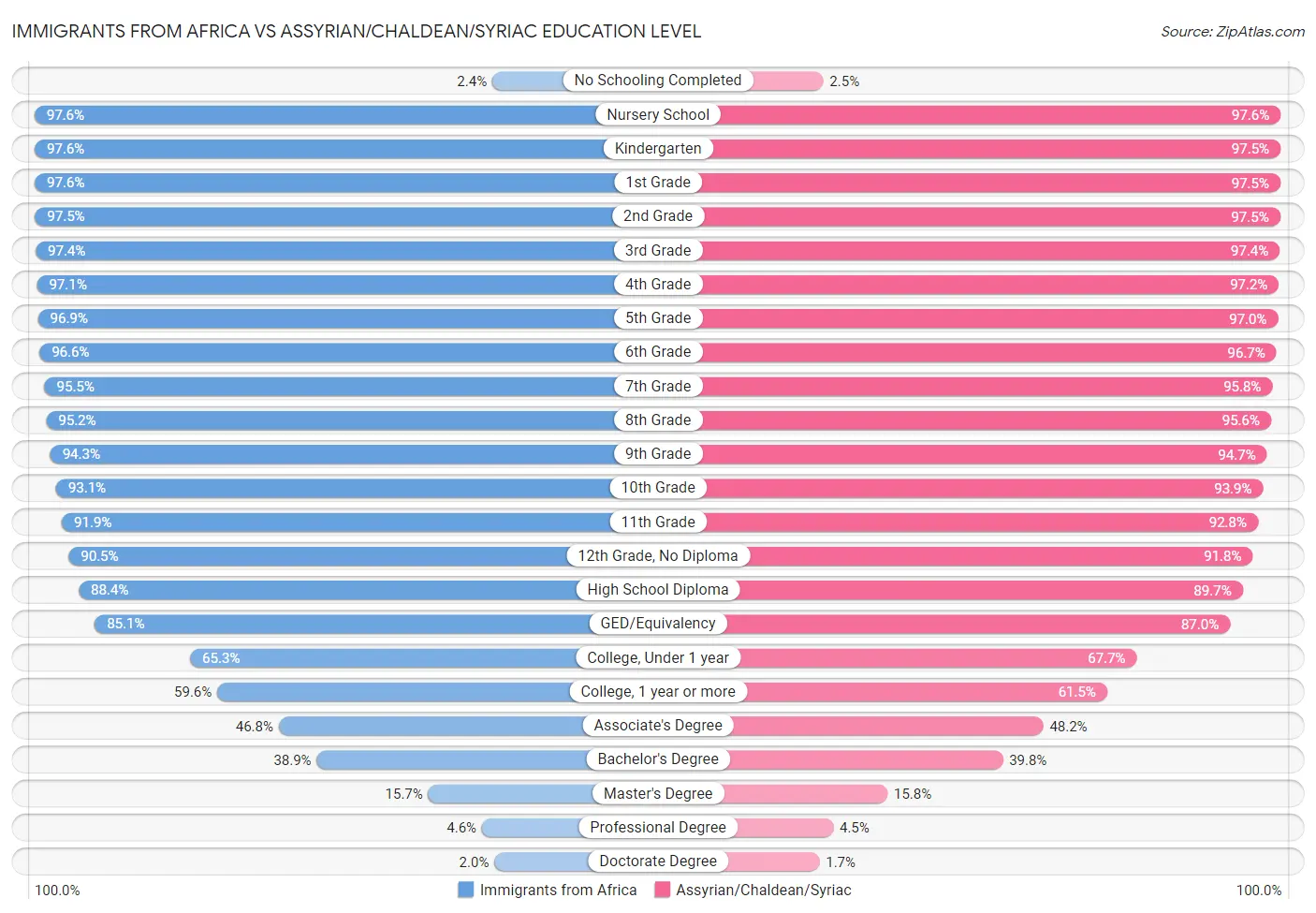
| Education Level Metric | Immigrants from Africa | Assyrian/Chaldean/Syriac |
| No Schooling Completed | Tragic 2.4% | Tragic 2.5% |
| Nursery School | Tragic 97.6% | Tragic 97.6% |
| Kindergarten | Tragic 97.6% | Tragic 97.5% |
| 1st Grade | Tragic 97.6% | Tragic 97.5% |
| 2nd Grade | Tragic 97.5% | Tragic 97.5% |
| 3rd Grade | Tragic 97.4% | Tragic 97.4% |
| 4th Grade | Tragic 97.1% | Tragic 97.2% |
| 5th Grade | Tragic 96.9% | Tragic 97.0% |
| 6th Grade | Tragic 96.6% | Tragic 96.7% |
| 7th Grade | Tragic 95.5% | Fair 95.8% |
| 8th Grade | Tragic 95.2% | Fair 95.6% |
| 9th Grade | Tragic 94.3% | Fair 94.7% |
| 10th Grade | Tragic 93.1% | Good 93.9% |
| 11th Grade | Tragic 91.9% | Excellent 92.8% |
| 12th Grade, No Diploma | Tragic 90.5% | Excellent 91.8% |
| High School Diploma | Poor 88.4% | Excellent 89.7% |
| GED/Equivalency | Poor 85.1% | Exceptional 87.0% |
| College, Under 1 year | Average 65.3% | Exceptional 67.7% |
| College, 1 year or more | Average 59.6% | Exceptional 61.5% |
| Associate's Degree | Good 46.8% | Excellent 48.2% |
| Bachelor's Degree | Good 38.9% | Excellent 39.8% |
| Master's Degree | Excellent 15.7% | Excellent 15.8% |
| Professional Degree | Good 4.6% | Good 4.5% |
| Doctorate Degree | Excellent 2.0% | Tragic 1.7% |
Immigrants from Africa vs Assyrian/Chaldean/Syriac Disability
When considering disability, the most significant differences between Immigrants from Africa and Assyrian/Chaldean/Syriac communities in the United States are seen in hearing disability (2.7% compared to 3.3%, a difference of 22.1%), self-care disability (2.4% compared to 2.8%, a difference of 19.3%), and disability age 5 to 17 (5.7% compared to 5.0%, a difference of 13.9%). Conversely, both communities are more comparable in terms of disability age 65 to 74 (23.7% compared to 23.4%, a difference of 1.4%), disability age over 75 (47.3% compared to 49.1%, a difference of 3.7%), and female disability (11.9% compared to 12.5%, a difference of 4.5%).
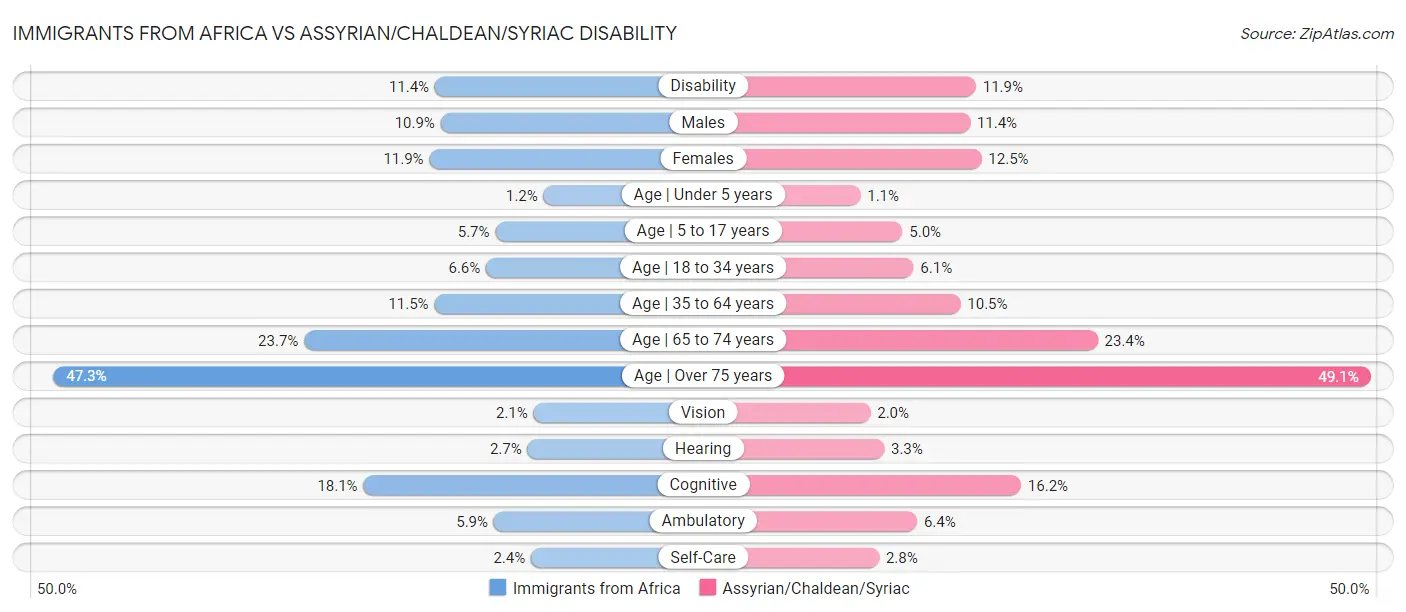
| Disability Metric | Immigrants from Africa | Assyrian/Chaldean/Syriac |
| Disability | Excellent 11.4% | Poor 11.9% |
| Males | Excellent 10.9% | Fair 11.4% |
| Females | Excellent 11.9% | Tragic 12.5% |
| Age | Under 5 years | Good 1.2% | Exceptional 1.1% |
| Age | 5 to 17 years | Poor 5.7% | Exceptional 5.0% |
| Age | 18 to 34 years | Average 6.6% | Exceptional 6.1% |
| Age | 35 to 64 years | Fair 11.5% | Exceptional 10.5% |
| Age | 65 to 74 years | Fair 23.7% | Average 23.4% |
| Age | Over 75 years | Average 47.3% | Tragic 49.1% |
| Vision | Good 2.1% | Exceptional 2.0% |
| Hearing | Exceptional 2.7% | Tragic 3.3% |
| Cognitive | Tragic 18.1% | Exceptional 16.2% |
| Ambulatory | Exceptional 5.9% | Tragic 6.4% |
| Self-Care | Exceptional 2.4% | Tragic 2.8% |